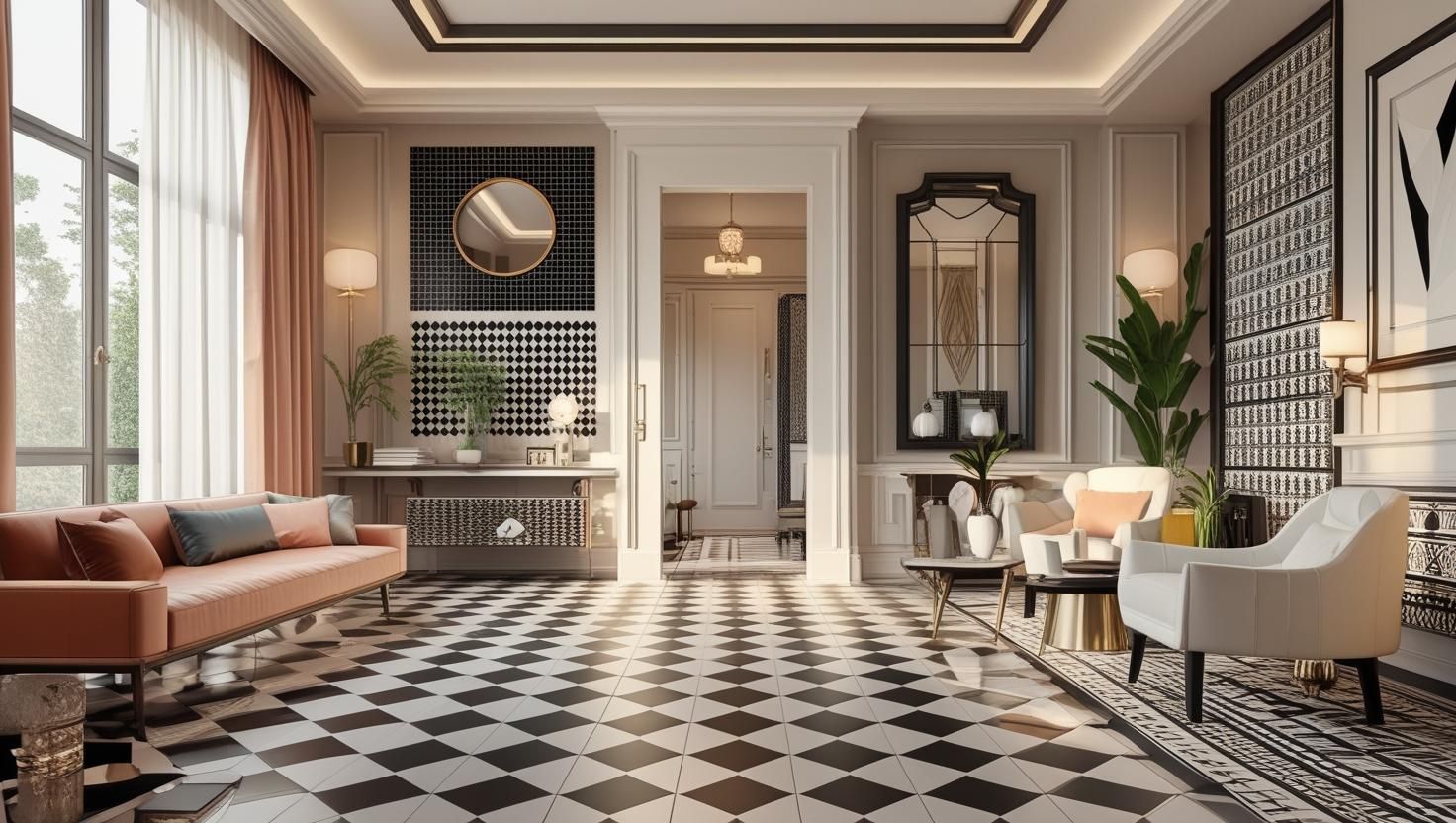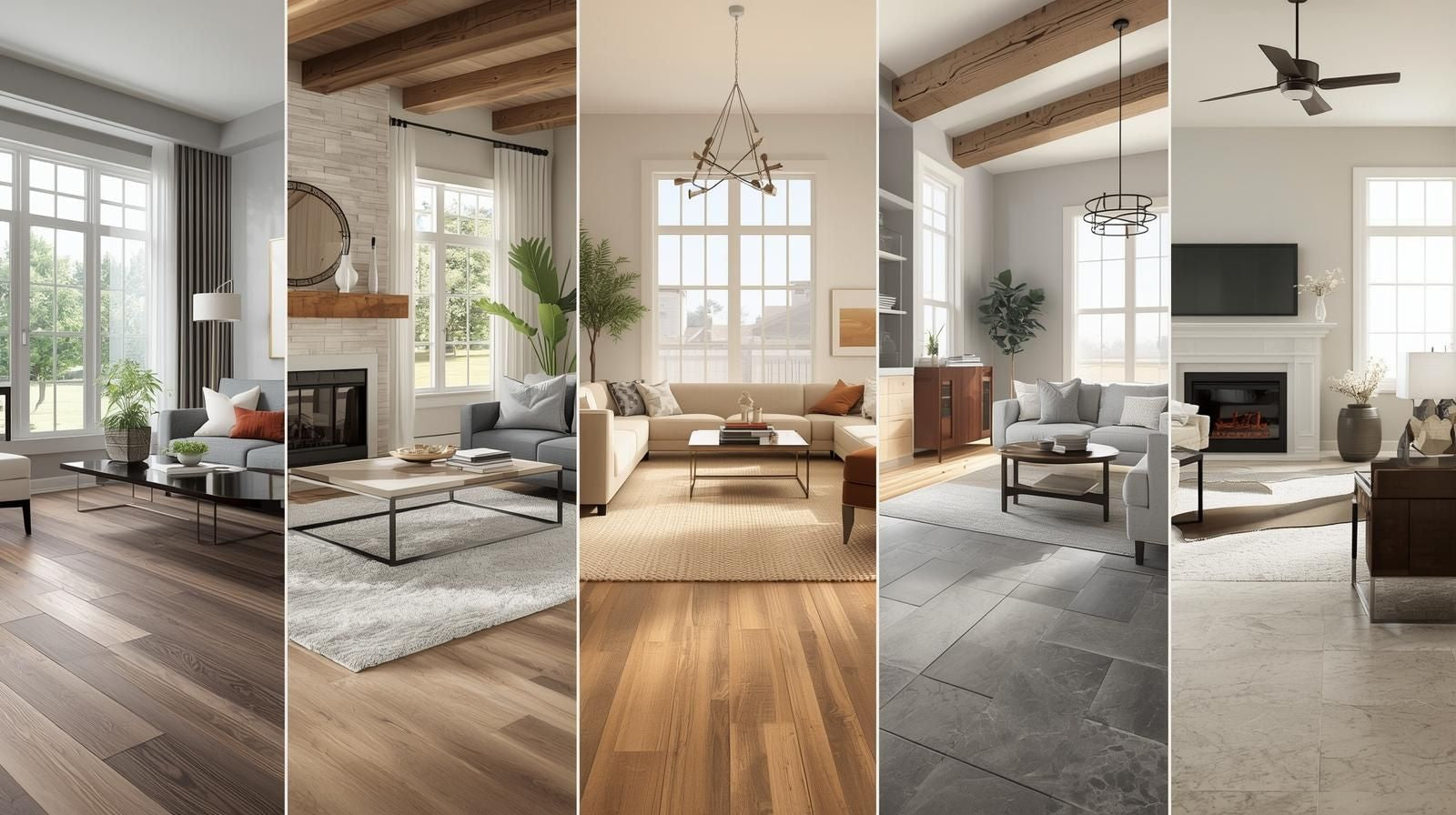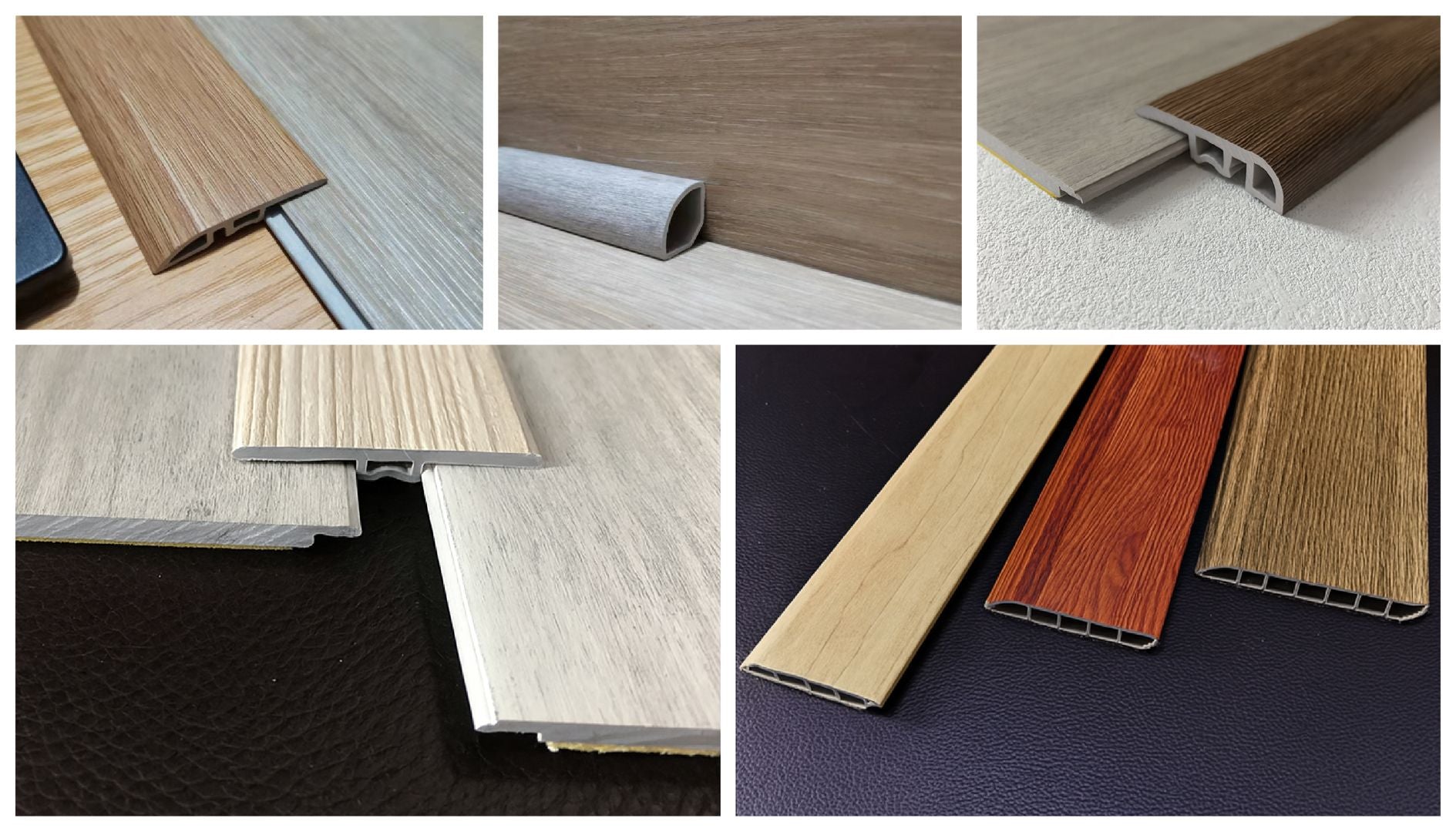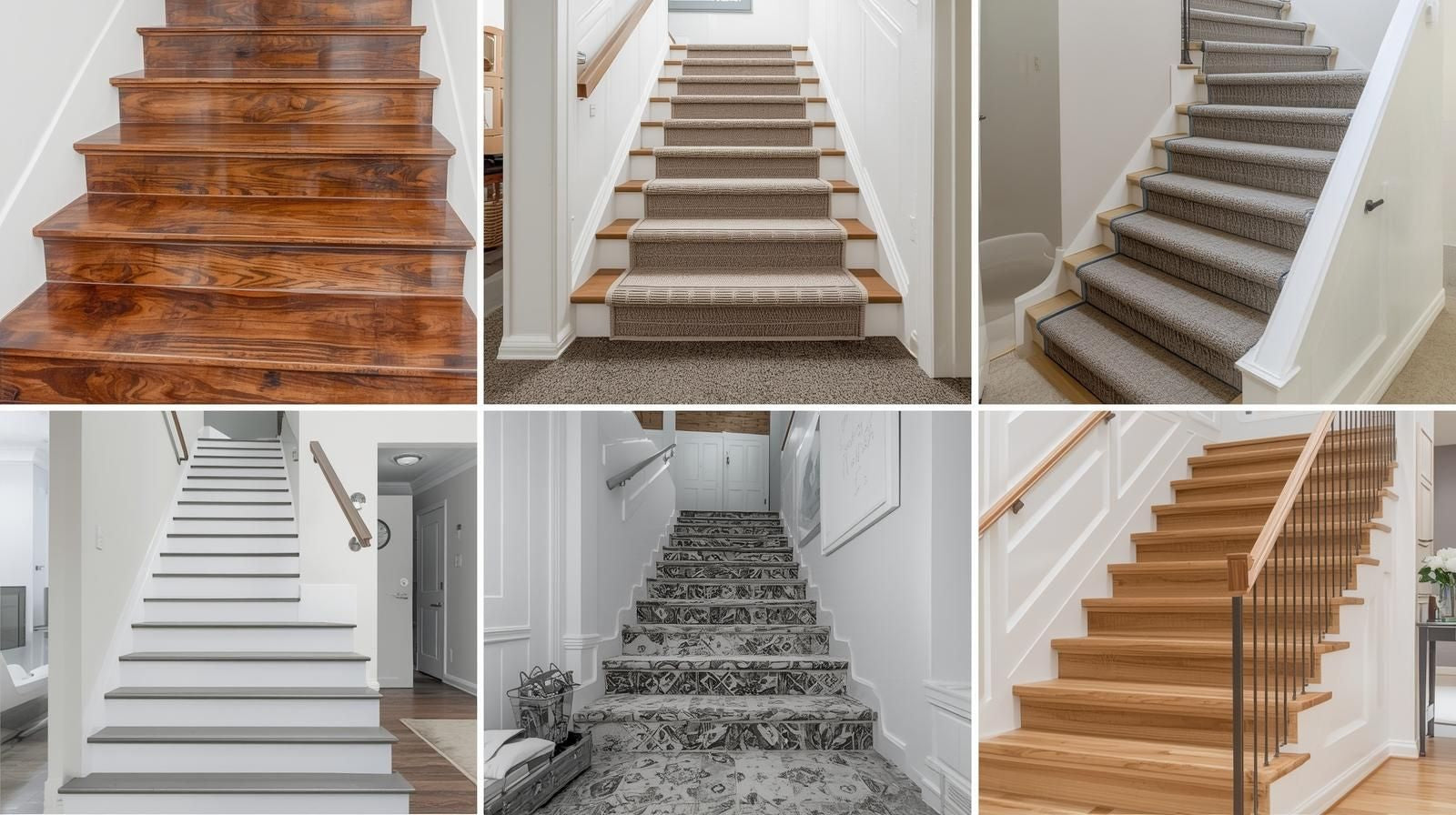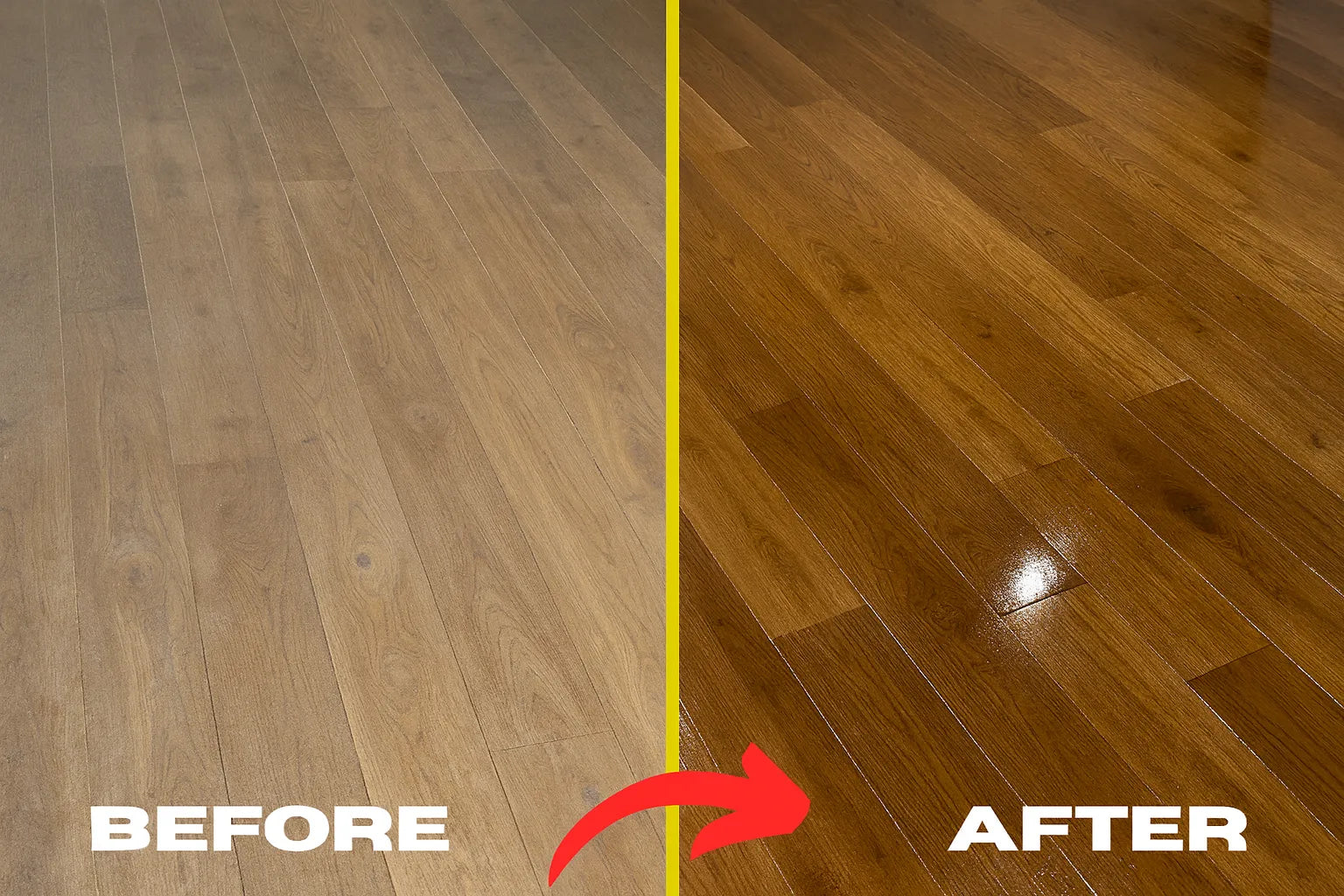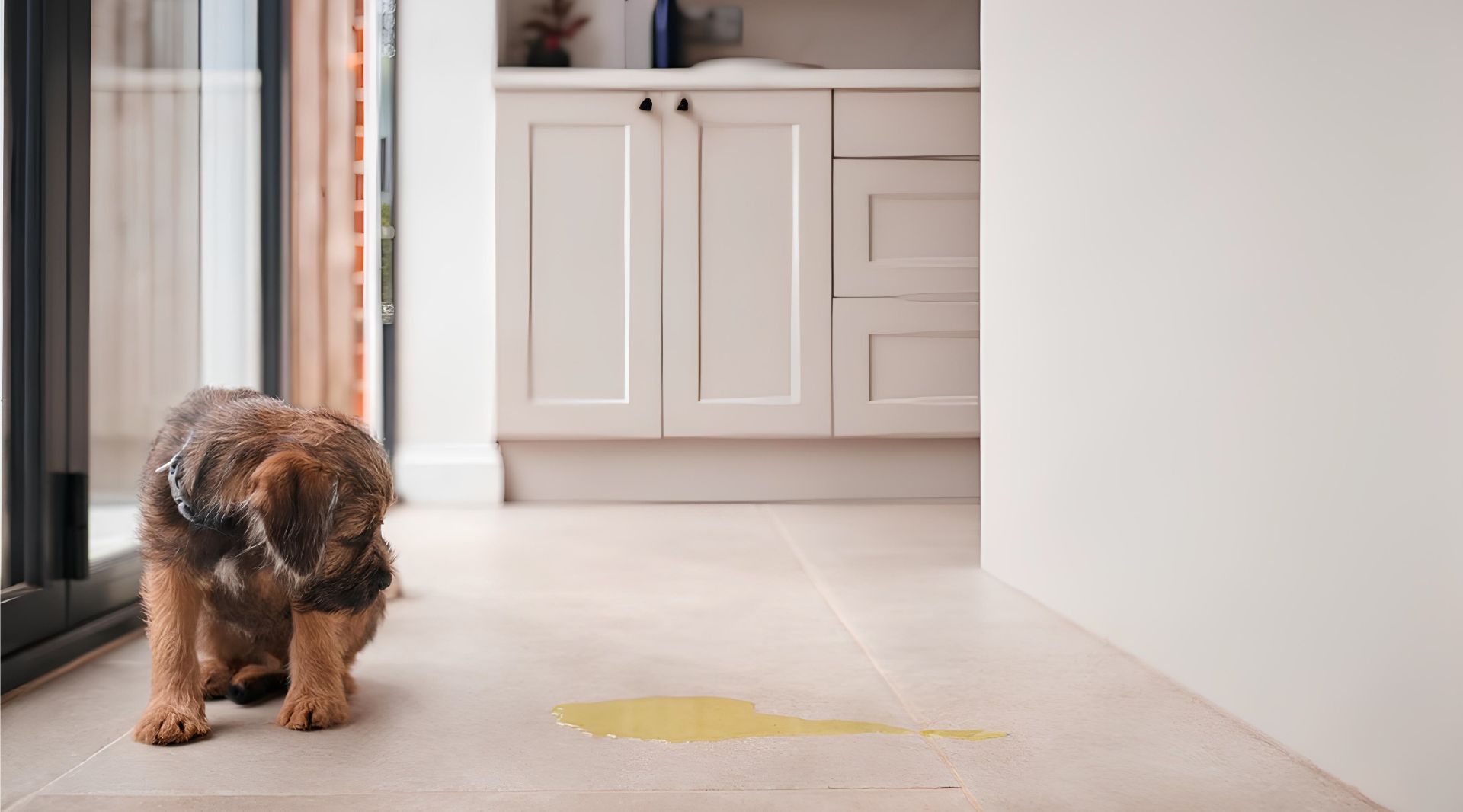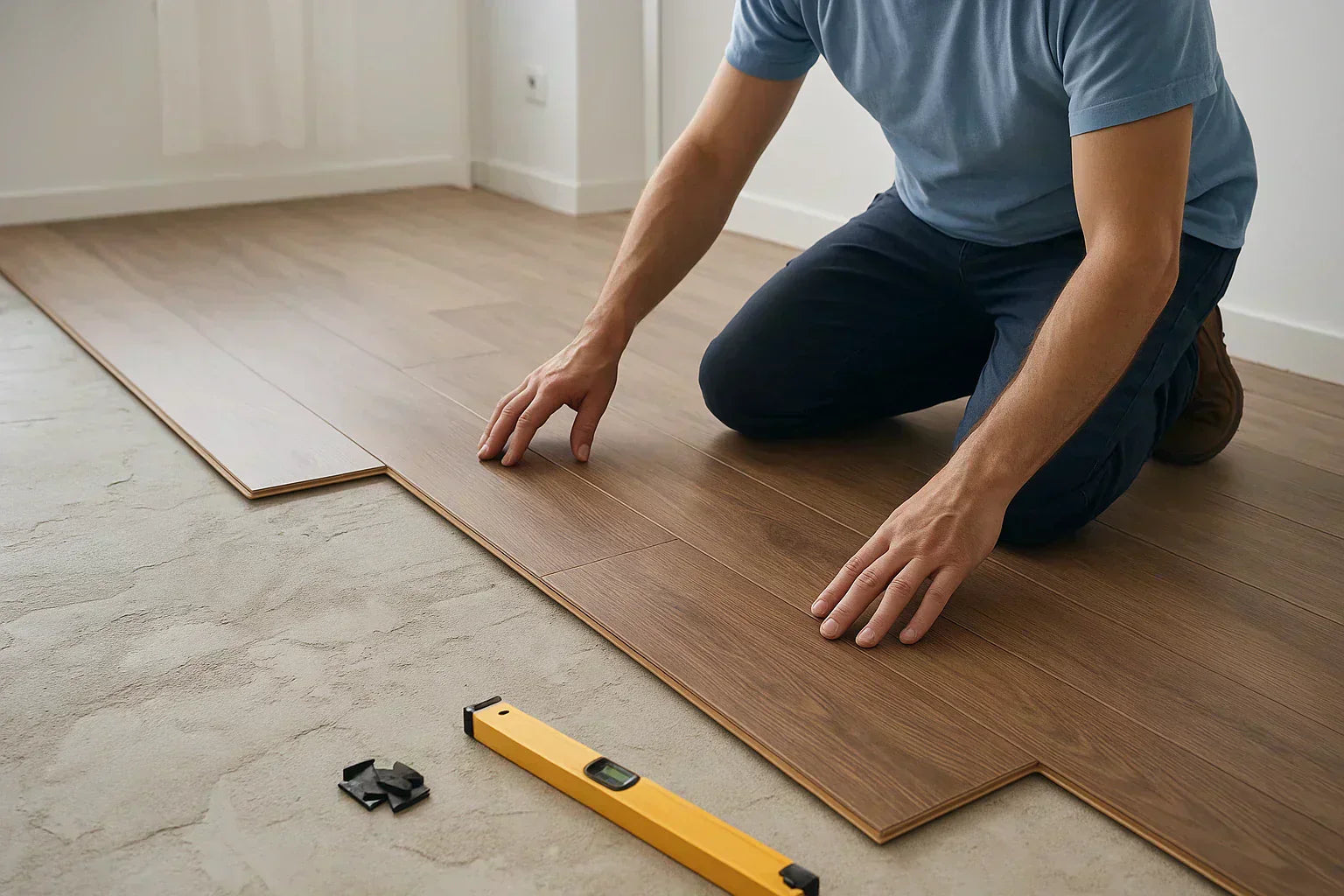The drawing room of any house is a statement room that sets the first impression on the guests. We fuss over wall colors, cushions, and curtains, but the tiles? They quietly hold the whole space together. The proper selection of floor tiles can completely change the feel of the room, making it warmer, brighter, more open, or even a bit dramatic if that is something you are interested in.
Tiles are also not just about the looks, as they have to deal with everything from muddy shoes to the occasional tea spill. So if you are planning to redo your drawing room, or even just dreaming about it, it’s worth taking a closer look at what’s under your feet.
Here we are sharing the best options for the drawing room floor tiles so you can pick the one thoughtfully.
1. Luxury Vinyl Tile (LVT)

Waterproof Vinyl Flooring is a durable, non-degradable type of flooring material that is constructed of layered PVC. Due to the realistic wood, marble, or stone appearances, it is deemed a choice among homeowners today. The design stays attractive, and the surface holds up well under daily use.
The layered design includes a UV-protected wear surface, a high-quality printed image layer, a strong vinyl center, and a padded bottom layer that adds comfort and prevents movement. LVT provides you with multiple options to choose from its different types, depending on the material used.
Key Benefits of Installing LVT in the Drawing Room
- 100% waterproof, making it resistant to spills and humidity.
- Noise reduction helps a lot, especially in drawing rooms that tend to echo. This feature makes the space feel quieter and more comfortable to be in.
- It has strong resistance to scratches and dents. That makes it a smart choice if there are pets or children in the house who run around or drop things.
- You can pick between glue-down installation and click-lock floating systems.
Both are easy to manage, depending on your floor base and what kind of setup you prefer. - LVT from top brands comes in wood-look planks, stone-look tiles, and abstract textures. Beveled edges, embossed finishes, and realistic grains.
LVT is a smart choice for transitional, stylish, or eclectic drawing rooms where comfort and easy upkeep matter most.
2. Ceramic Tiles – Affordable and Easy to Maintain

Homeowners often go for ceramic tiles; they don’t cost much and need little care. They match different room styles with ease. Clay mixed with sand and water gets shaped and then baked under high heat. You’ll find some tiles with a glossy surface. Others carry a matte finish, giving the space a solid, grounded feel.
There are two major types of ceramic tiles people usually consider.
- Glazed Ceramic Tiles: For a shiny, protective surface in your drawing room, light-use areas
- Unglazed Ceramic Tiles: More natural in appearance with greater slip resistance.
Satin matte or semi-gloss ceramic tiles are perfect in the drawing rooms. The tile design is elegant and makes matters simple as far as cleaning is concerned.
Key Features of Ceramic Tiles
- You’ll find them in numerous designs, tones, and textures.
- Their insulation helps floors feel cooler underfoot in hot areas.
- Well-sealed tiles block out stains, mold, and bacteria easily.
📢 Just a tip: These tiles are strong for daily use. Still, they can break or chip if something heavy or sharp falls on them. Porcelain tiles do better with sudden impact. Using rugs in busy areas or pads under furniture can help keep the tiles in better shape over time.
Best for budget-friendly drawing room designs where frequent style updates or minimal upkeep are desired.
3. Porcelain Tiles – Durable and Stylish

Porcelain tiles are manufactured with high-fired refined clay and minerals and are denser and less porous when compared with ceramic tiles. They are extremely hard and stain-resistant, and hence, are demanded to be used in both homes and offices.
Key Properties of Porcelain Tiles
- Water absorption rate is less than 0.5%, making them virtually waterproof.
- Rated high on the Mohs hardness scale, excellent for scratch and chip resistance.
- PEI rating 4 or 5, suitable for heavy residential use.
- Available in wood-look, stone-look, concrete-look, or fabric-textured finishes.
- Options for rectified edges, which allow for tighter grout lines and a seamless look
Porcelain tiles are thick and heavy; hence, their cutting and installation are more difficult. This is why people should have certain skills and implement specific tools. It is necessary to apply a powerful tile adhesive to get good results. Also, the smoothness and uniformity of the subfloor keep the tiles in the right position.
Select anti-slippery porcelain tiles (R9-R11) which are also non-slippery on the floor surface and have fast traction, provided you have a drawing room which is adjacent to a patio, garden, or wet space.
Perfect for homeowners seeking sleek, modern drawing room designs that can handle high foot traffic with minimal wear.
4. Hardwood Tiles – Warm and Aesthetic Appeal

Hardwood tiles (also known as wood-look tiles) combine the warmth and natural look of wood with the durability of ceramics or porcelains. These tiles will give a realistic woodgrain finish, but maintenance issues associated with real timber are eliminated.
Aesthetic Features of Hardwood Tiles for the Drawing Room
- Mimic species like oak, teak, walnut, and mahogany.
- Available in long plank formats, herringbone patterns, or chevron designs.
- Scratch-proof, fade-resistant, and won’t warp with humidity.
- Provide textural warmth and acoustic comfort.
- Compatible with underfloor heating.
Engineered hardwood floorings and porcelain wood tiles are among the different types of hardwood tiles for your drawing room. You can choose your matching engineered hardwood from the well-known brands.
A top choice for rustic, farmhouse, or Scandinavian-themed drawing rooms where authenticity and visual warmth are desired.
5. Marble Tiles – Luxurious and Elegant

These marble tiles shine in a conspicuous way that is classy and prosperous. They are common in luxurious houses due to the slick and shiny finish and the beautiful veining. Such tiles can be made of marble, which is a rock that forms under the pressure which is found deep in the earth. That is how it acquires its fluffy consistency and wide palette of colors.
You’ll find many people choose marble not just for how it looks, but also for the calm and cozy feel it brings to a room. There are several types that designers prefer.
- Carrara Marble (Italy)
- Makrana Marble (India)
- Emperador Marble (Spain)
Marble tiles can be used in formal, classic, or high-end luxury interiors, and are, therefore, the best option when one feels the need to have the drawing room emit classic elegance, culture, and art.
- Glossy, smooth surface that reflects light and enhances the color depth.
- Marble remains naturally cool.
- Used over radiant heating systems with proper insulation.
It is easy to maintain: only pH-neutral, acidic or harsh cleaners can be used, which will destroy the finish in the long run. Pad under furniture and non-scratch rugs to prevent destruction of high-traffic routes.
Marble tiles do best in formal, classic, or high-end luxury interiors, and they are well recommended when one desires a drawing room to exude a classic touch, cultural brilliance, and the artistic spirit to its core.
6. Granite Tiles – Natural and Strong

Granite ranks as one of the strongest natural stones used in floors. It handles heat well and won’t scratch easily. You’ll notice its naturally speckled look, which gives each tile a unique character. These tiles come from large stone blocks, cut down and either left textured or polished until smooth.
Key Features Granite Tiles
- Extremely dense and non-porous.
- Natural resistance to scratches, heat, and abrasions.
- Available in a range of colors, including black galaxy, Kashmir white, and red multi.
- Polished for a high-gloss look.
- Flamed or bush-hammered for anti-slip applications.
Installation Notes: Heavier than other tile types, it requires a solid subfloor.
A long-term investment for drawing rooms in need of a tough, natural surface that will age beautifully over time.
7. Vitrified Tiles – Moisture and Scratch Resistant

Vitrified tiles are artificial and go through a process of vitrification, which entails the melting together of silica and clay at high temperatures to form a non- porous surface of glass-like nature. Vitrified tiles have the following categories.
Strengths of Vitrified Tiles
- High durability and gloss retention.
- Low porosity means better stain, water, and bacteria resistance.
- Perfect for heavy foot traffic areas and long-term usage.
- Available in large slabs (800x800 mm, 600x1200 mm), ideal for seamless layouts.
A reliable choice for contemporary or minimalist drawing rooms demanding a clean, glossy, and durable surface.

Design Ideas for Drawing Room Floor Tiles

A wide variety of tile materials, patterns, and finishes are available today, so you can blend creativity with functionality to make your space truly stand out.
1. Mix and Match Styles
Mix tile types, including wood-look porcelain and stone-effect vitrified tiles to layer up spaces within an expansive floor plan. This method brings depth and dimension to and still has an integrated appearance. The installation of a warm- and cool-temperature tile beneath a sitting area and walkways, respectively, allows the soft sectionalized differentiation without employing walls or carpets.
- Great for open-concept or multi-functional drawing areas.
- Offers a dynamic, layered design using contrast and complementary finishes.
- Popular with transitional and eclectic interior themes.
2. Checkerboard or Black & White Tiles
A vintage pattern, black and white, checkers tile patterns instantly adds a dramatic look and glamour to a drawing room. The design is compatible with both a conventional and a post-modern layout, bringing either an option of old-fashioned chic or a hint of minimalist audacity, depending on the tile surface.
- Use matte finishes for a subtle vintage look or polished tiles for a sleek modern feel.
- Ideal for monochrome or Art Deco-inspired décor themes.
- It can be installed diagonally for a more dramatic, expansive visual effect.
3. Textured or 3D Effect Tiles
Tiles with texture bring life to your floor; they turn it into more than just a surface. A 3D pattern or textured finish adds a sense of touch that becomes part of the room's story. These work especially well in spaces with minimal decor or soft, neutral colors, where every detail matters.
- Choose stone-look or embossed ceramic tiles to introduce depth without overwhelming the space.
- Enhances the sensory and visual appeal, especially effective under natural lighting or soft interior lights.
- Works beautifully with earthy, boho, or contemporary design schemes.
4. Geometric and Mosaic Designs
Use geometry, herringbone patterns or inlaid mosaics to add pattern play and character to your drawing room. Choose delicate pastel mosaics or dramatic geometric contrasts but all these designs are decorative and functional.
- Use hexagonal tiles, chevron patterns, or micro mosaics to create a feature floor.
- Excellent for drawing attention to a central seating area or anchoring the overall layout.
- Matches well with mid-century modern, Mediterranean, or contemporary interior
📌Pro Tip: The right combination of pattern and texture with your furniture layout, room lighting, and color palette can turn your drawing room into a design statement.
Pros and Cons of Tile Flooring For Your Drawing Room
| PROS | CONS |
| Highly durable and long-lasting, resistant to scratches, wear, and heavy foot traffic | Harder materials may crack under impact or if the subfloor is uneven |
| Most tile types are moisture-resistant and non-porous | Grout lines may require periodic cleaning and sealing to prevent discoloration |
| Anti-slip finishes and textured surfaces reduce slipping hazards | Can feel hard and cold |
| Hypoallergenic surface that does not trap dust, dander, or pollen | Improper subfloor prep can impact heating efficiency. |
| Excellent for spill-prone zones. Low water absorption rate (<0.5% for porcelain), ideal for homes with kids, pets, or humid climates. | Heavier carbon footprint compared to bamboo or reclaimed wood alternatives. |
| Long-lasting investment with minimal upkeep when installed professionally. High dimensional stability and doesn’t warp or shrink. |
✅ Tiles are a smart long-term investment for drawing rooms, especially in homes seeking low-maintenance, allergen-free, and design-flexible flooring.
⚠️ However, it’s essential to weigh comfort, installation needs, and room usage before choosing your tile type.
How to Select Tiles for the Drawing Room?

The perfect tiles for your drawing room are the ones that are selected, keeping all the factors in mind.
1. Room Size and Functionality
A small room can feel bigger just by choosing the right tiles. Go for large-format tiles in lighter shades; they create a smoother surface and fewer visible lines. Larger rooms, though, can take richer colors, natural textures, or bold designs without looking crowded.
Where there’s a lot of movement, you need strong tiles. Granite, vitrified, or porcelain handles this kind of pressure well. For rooms that are more about style than use, marble or glazed ceramics add charm and class.
2. Colors and Patterns Matching with Furniture and Wall Paint
Tiles should look like they belong with the rest of your interior. Check how the tile shade fits with furniture color, wall paint, and curtains.
- Warm beige or soft grey tiles often work best for clean and simple layouts. They're easy to match with changing styles.
- If your room has a more traditional or creative vibe, try wood-styled tiles or bold patterns.
- Warm tones like honey and walnut look great near wooden pieces. Grey slate or icy marble pairs better with metallic or black-and-white furniture pieces.
3. Lighting and Interior Style
The light affects the appearance of the tiles during the day. Classy tiles are shiny and made to illuminate the sunlit areas, whereas matte or rough tiles are more suitable in a room with much glare or dimmer lighting.
Wood and stone-look or wood-effect tiles to bring in rustic appeal, marble or vitrified tiles to create an old-world classy appeal, and concrete and slate-like finish tiling to create an industrial-like backing.
Larger square tiles or rectangles give the impression of a bigger drawing room with fewer lines of grout, making the area seem open at a glance when placed in diagonal form or staggered.
Average Cost of Drawing Room Floor Tiles
| Tile Type | Total Avg. Cost (Per Sq. Ft.) |
Maintenance Notes |
| Ceramic Tiles | ₹85 | Easy to clean, reseal grout yearly, prone to chipping under impact. |
| Porcelain Tiles | ₹145 | Low maintenance, water and stain resistant, ideal for high-traffic areas. |
| Vitrified Tiles | ₹150 | Highly durable and glossy; simple upkeep with regular mopping. |
| Marble Tiles | ₹500 | Requires sealing and careful cleaning; avoid acids and abrasives. |
| Granite Tiles | 250 | Long-lasting and strong; needs stone-safe cleaners and occasional sealing. |
| Luxury Vinyl Tiles | ₹190 | Comfortable and moisture-resistant; clean with a damp mop. |
| Hardwood Tiles | ₹380 |
Attractive but sensitive to moisture; maintain with wood-safe products. |
FAQs
What Shape Tile Makes a Drawing Room Look Bigger?
Larger square tiles or rectangles give the impression of a bigger drawing room with fewer lines of grout, making the area seem open at a glance when placed in diagonal form or staggered.
Which Size of Floor Tiles is Best for a Drawing Room?
The best types of tiles to be used in drawing rooms are the large formats, i.e., 600x600 mm or 800x800 mm. They reduce eye visual clutter, ensure maximum space, and have a streamlined, modern look.
The Bottom Line
When considering your drawing area, consider more than appearances. And with these in mind, weigh the compatibility of each tile type with your everyday living, the amount of traffic you have, and the maintenance time you can spare.
Still unsure? It is all right to seek help.
You are welcome to contact floor specialists or designers, or call us via number (833) 378-4559.)


